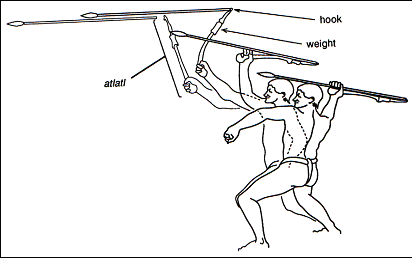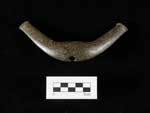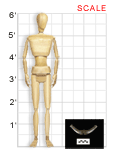From the collection of:
William S. Webb Museum of Anthropology || VAM Home
BANNERSTONE (ATLATL WEIGHT), Middle and Late Archaic Period, c. 6000-1000 BCE
Exact site unknown, Midwestern United States
Ground and polished granitic stone; 15.5 cm X 6.5 cm X 2.5 cm
Catalog Number 76-8-2
William S. Webb Museum of Anthropology, University of Kentucky
Native craftsmen made atlatl (pronounced at-lattle) weights in a variety of shapes and from many different types of material. Very hard stone such as granite or quartzite was the most common material for atlatl weights, but bone and shell also were used. The atlatl, or throwing stick as it is sometimes called, was the primary weapon used by native peoples before development of the bow and arrow. It consists of a shaft with a hook on one end, a weight in the middle of the shaft, and a handle on the opposite end. A hole was drilled through the weight to accommodate the shaft. The atlatl acts as a lever to help propel a spear with more force, and the stone is thought to be a counterweight when holding the spear thrower.
The elaborate shapes and fancy workmanship of atlatl weights suggest that their makers valued these artifacts as more than just weights. Therefore, they are sometimes referred to as “bannerstones” because each one is distinct and exceptionally well made. The particular style pictured here is referred to as a knobbed crescent because of the small knobs at either end of the crescent-shaped stone. The atlatl weight or bannerstone was a common artifact made by native peoples in Kentucky and the middle Ohio Valley area from 8,000 to 3,000 years ago.
Classroom Ideas
Discussion: What, if anything, makes an object such as this one a work of art? What tools do you think were used to create this bannerstone? What can an object like this teach us about the culture that created and used it?
Activity: Research the Archaic Period in history (see links below). What advancements were made during this time? How did people communicate with one another? What do scientists suggest life was like for people during this period? Where are some sites in the Southeastern or Midwestern parts of the United States that show evidence of human civilization during the Archaic Period? Focus on some aspect of this period that interests you—for example, a nearby archaeological site or a technological advancement—and create a PowerPoint® presentation for the class with information and visuals.
Links
Learn more about Kentucky archaeological sites and discoveries at the Kentucky Archaeological Survey web site.
[www.kyheritage.org/kas.htm]
For information about the Archaic Period, visit the National Park Service’s Southeast Archaeological Center.
[www.cr.nps.gov/seac/archaic.htm]
BPS Engineering’s Atlatl.com has an overview of the mechanics and engineering behind the atlatl or spearthrower.
[www.atlatl.com]
The Society of Primitive Technology and the Hollowtop Outdoor Primitive School both offer information about making and using ancient tools, including atlatls.
[www.primitive.org]
[www.hollowtop.com/pls.htm]
See the William S. Webb Museum of Anthropology site for lots of teaching resources, including information about time periods, online activities, and lesson plans.
[www.uky.edu/AS/Anthropology/Museum/museum.htm]

